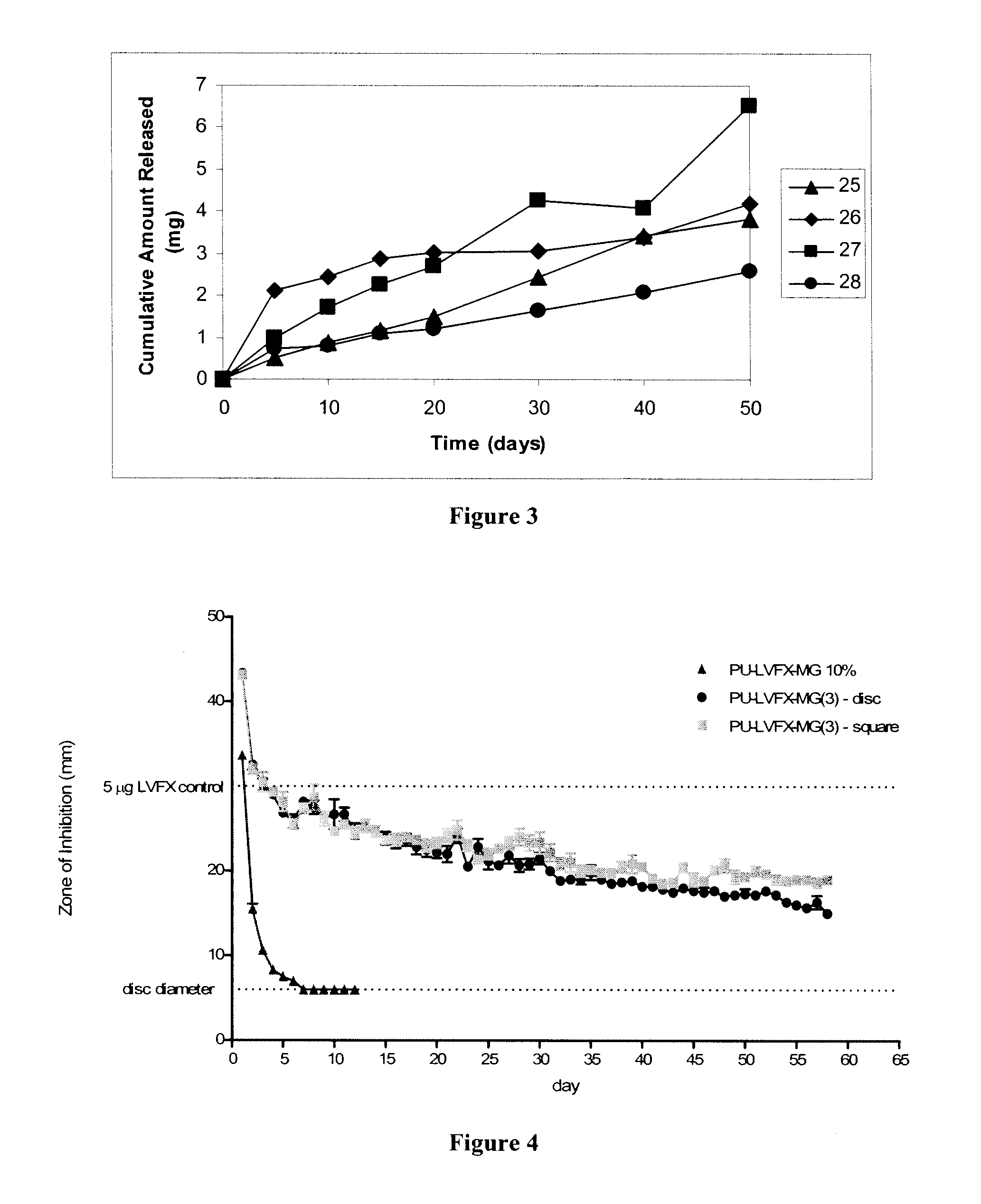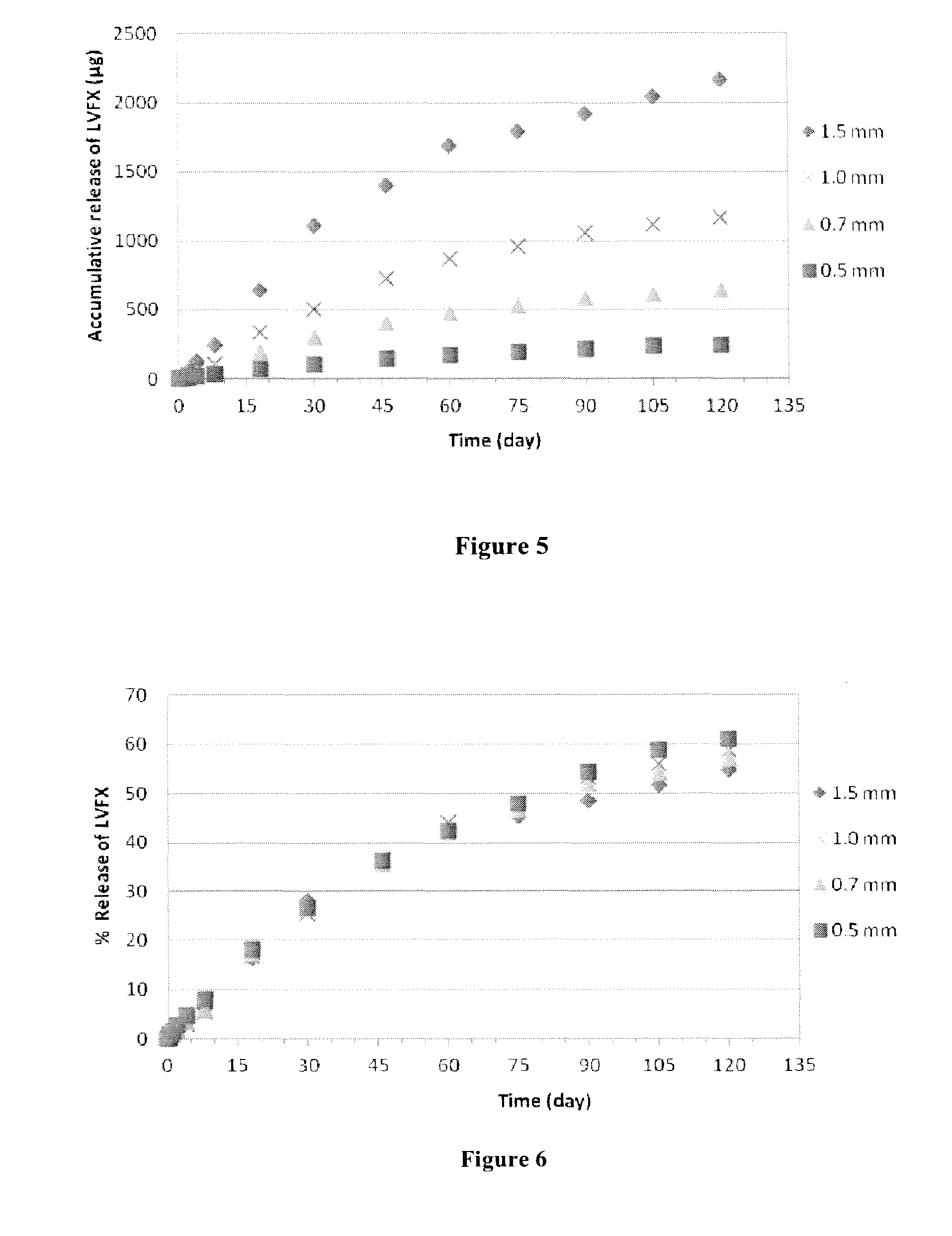Biodegradable polymer-bioactive moiety conjugates
a bioactive and polymer technology, applied in the field of polymerbioactive moiety conjugates, can solve the problems of poor control of the release rate of drugs, uncontrolled dosages, and large dependence on the release of therapeutic agents, and achieve the effect of effective and efficien
- Summary
- Abstract
- Description
- Claims
- Application Information
AI Technical Summary
Benefits of technology
Problems solved by technology
Method used
Image
Examples
example 1
Valproic Acid Monoglyceride (VA-MG)—For comparative Examples
(a) 2-propylpentanoic acid, 2,2-dimethyl-1,3-dioxolane-4-yl methyl ester
[0523]
[0524]2-propylpentanoic acid (10.00 g; 0.07 mol) was dissolved in dichloromethane (anhydrous) (500 ml), under an argon atmosphere. 2,2-dimethyl-1,3-dioxolane-4-methanol (solketal) (11.00 g; 0.08 mol; 1.2 equiv) and p-dimethylaminopyridine (1.02 g; 8.30 mmol; 0.12 equiv) were added. The solution was cooled to 0° C. and a solution of 1,3-dicyclohexylcarbodiimide (17.17 g; 0.08 mol; 1.20 equiv) in dichloromethane (anhydrous) (100 ml) was added dropwise over 30 minutes. A white precipitate formed during the addition. The reaction mixture was allowed to warm to ambient temperature and stirred at ambient temperature for 16 hours. The reaction mixture was cooled in a dry ice / acetone bath (−78° C.) followed by filtration to remove the urea precipitate. The solvent was removed in vacuo to obtain the crude product as a clear, colourless oil (23.29 g) which ...
example 2
3-(1,3-dihydroxypropan-2-yloxy)-3-oxopropyl 2-propylpentanoate
a) 3-hydroxypropyl 2-propylpentanoate
[0529]
[0530]2-propylpentanoic acid (10.0 g, 69.3 mmol) was mixed with propane-1-3-diol (42.1 g, 555.0 mmol) and methyl-sulfonic acid (5 drops) in toluene (200 ml) and the mixture was heated under reflux using a Dean Stark trap for 12 h. After that, toluene was removed under reduced pressure and the crude mixture was dissolved in dichloromethane (200 ml) and extracted with water (pH 5, 3×200 ml). The combined organic layers were dried over sodium sulfate and the volatiles were removed under reduced pressure giving a clear oil (14.0 g, 60.0 mmol, 99%).
[0531]1H-NMR (CDCl3, 200 MHz): δ[ppm]=4.24 (tr, 2H, J=6.1 Hz), 3.68 (tr, 2H, J=6.1 Hz), 2.37-2.31 (m, 1H), 1.93-1.77 (m, 2H), 1.69-1.16 (m, 8H), 0.89 (tr, 6H, 6.9 Hz)
b) 3-(2-propylpentanoyloxy)propanoic acid
[0532]
[0533]3-hydroxypropyl 2-propylpentanoate (2.08 g, 10.3 mmol) was dissolved in 120 ml of acetone. 3.1 ml of a solution of Jones Re...
example 3
Production of a Mixture of 1,2-dihydroxy-5,14-dioxo-4,15-dioxa-6,13-diazanonadecan-19-yl 2-propylpentanoate and 1-hydroxy-2-(hydroxymethyl)-4,13-dioxo-3,14-dioxa-5,12-diazaoctadecan-18-yl 2-propylpentanoate
a) 4-hydroxybutyl 2-propylpentanoate
[0541]
[0542]2-propylpentanoic acid (40.16 g, 278.5 mmol) was mixed with butane-1-4-diol (114.65 g, 1272.2 mmol) and methyl-sulfonic acid (5 drops) in toluene (3500 ml) and the mixture was heated under reflux using a Dean Stark trap for 12 h. After that, toluene was removed under reduced pressure and the crude mixture was dissolved in chloroform (200 ml) and extracted with water (pH 5, 3×200 ml). The combined organic layers were dried over sodium sulfate and the volatiles were removed under reduced pressure giving a clear oil (99%).
[0543]The product was analysed by NMR and found to be VA-BDO
b) 4-(6-isocyanatohexylcarbamoyloxy)butyl 2-propylpentanoate
[0544]
[0545]Solution A: 4-hydroxybutyl 2-propylpentanoate (VA-BDO) (10.4518 g 48.3) mmol) was drie...
PUM
| Property | Measurement | Unit |
|---|---|---|
| diameter | aaaaa | aaaaa |
| mol % | aaaaa | aaaaa |
| molar ratios | aaaaa | aaaaa |
Abstract
Description
Claims
Application Information
 Login to View More
Login to View More - R&D
- Intellectual Property
- Life Sciences
- Materials
- Tech Scout
- Unparalleled Data Quality
- Higher Quality Content
- 60% Fewer Hallucinations
Browse by: Latest US Patents, China's latest patents, Technical Efficacy Thesaurus, Application Domain, Technology Topic, Popular Technical Reports.
© 2025 PatSnap. All rights reserved.Legal|Privacy policy|Modern Slavery Act Transparency Statement|Sitemap|About US| Contact US: help@patsnap.com



